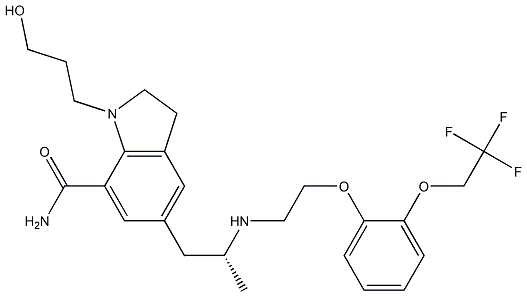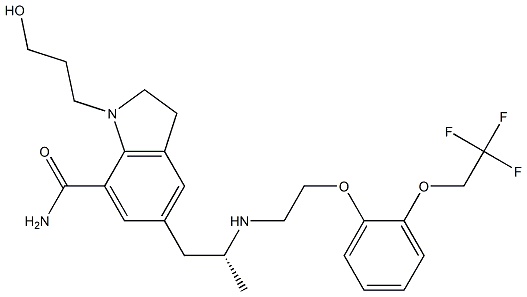


| Name |
|
|---|---|
| Synonyms | Silodosin-d4; Silodoxin; 1H-Indole-7-carboxaMide,2,3-dihydro-1-(3-hydroxypropyl)-5-[(2R)-2-[[2-[2-(2,2,2-trifluoroethoxy)phenoxy]ethyl]aMino]propyl]-; 1-(3-hydroxypropyl)-5-[(2R)-({2-[2-[2-(2,2,2-trifluoroethoxy)phenoxy]ethyl}aMino)propyl]indoline-7-carboxaMide; KAD 3213; KMD 3213; Urief; Silodosin API |
| CAS NO | 160970-54-7 |
| EINECS | 814-909-2 |
| Molecular Weight | 495.53 |
| Molecular Formula | C25H32F3N3O4 |
| Product Categories | KAD 3213, KMD 3213;Other APIs;Amines;Aromatics;Chiral Reagents;Heterocycles;Intermediates & Fine Chemicals;Pharmaceuticals |
| Mol File | 160970-54-7.mol |
| Silodosin Chemical Properties | |
|---|---|
| Boiling point | 601.4±55.0 °C(Predicted) |
| density | 1.249±0.06 g/cm3(Predicted) |
| alpha | D25 -14.0° (c = 1.01 in methanol) |
| pka | 14.85±0.10(Predicted) |
| CAS DataBase Reference | 160970-54-7(CAS DataBase Reference) |
| Safety Information | |
|---|---|
| HS Code | 29339900
|
| Silodosin Usage And Synthesis | |
|---|---|
| Treatment of prostatic hyperplasia | Silodosin is a kind of α-adrenergic receptor antagonists developed by Japanese Kissei pharmaceutical company. It has a very good therapeutic efficacy on treating the dysuria related to benign prostatic hyperplasia. The selective effect on urethra of Silodosin is 12 times and 7.4 times as high as that of prazosin and tamsulosin, respectively, which can significantly inhibit norepinephrine-induced contraction of the prostate; it has dose-dependent inhibition bladder activity excitation in the benign prostatic hypertrophy models of rats, and can also improve the pressure threshold of bladder contraction. These data have suggested that, in addition to helping improve bladder function, silodosin is also effective in alleviating the related symptoms associated with benign prostatic hypertrophy. Compared with similar drugs such as prazosin and tamsulosin, silodosin has a high selectivity onn theα1A-receptors located in the prostate and bladder neck, while having a low affinity to theα1B-and α1D-receptor. It can block theα1A-receptors in these sites, and relax the smooth muscle, and thus leading to the improvement of urinary flow rate and the alleviation of BPH symptoms. The selective binding to the α1A-receptor by silodosin has a higher selectivity compared to the binding to the cardiovascular associated receptors α1B, thus maximizing the activity of the target organ as well as minimizing the potential effect on blood pressure. The above information is edited by the chemicalbook of Dai Xiongfeng. |
| Benign prostatic hyperplasia | Benign prostatic hyperplasia (referred as BPH) is one of the most common diseases in older male with the non-malignant prostate being the character. |
| Uses | It can be used for treatment of benign prostatic hyperplasia. |
| Description | Silodosin, an a1A adrenoceptor (a1A-AR) antagonist selective for prostatic receptors, was launched as an oral treatment for dysuria associated with benign prostatic hypertrophy (BPH). The regulation of smooth muscle tone in the bladder neck and prostate is thought to be primarily mediated by a1A-AR. Blockade of these receptors can cause smooth muscle relaxation in these areas, resulting in improved symptoms and urinary flow rates. Conversely, a1B-AR are largely located on vascular smooth muscle, and antagonism of these receptors can cause tissue relaxation and potentially decrease cardiac compensation mechanisms involved in regulating blood pressure. |
| Chemical Properties | White Solid |
| Package method |
|---|

FAQ
MOQ: 100 gram
Pack material: Plastic bag + Shockproof film + shockproof envelope + Cartons.
Shipment: By express to buyers’ door. 100% make sure delivery.
Payment: TT/ Western Union/BTC/ETV/VISA and so on, please contact by email.
Shipment time: Within three working days after payment. Usually need ten days to arrive buyers’ address. Resend if lost


Boldenone, Oxymetholone, Drostanolone, Testosterone, Nandrolone, Trenbolone
Designed by HuishangMedia
Copyright © 2008-2022 J·S Biology Co.,LTD All Rights Reserved
Design by Huishang Media
Under CC: ultimatearm, Freepik, Nhor Phai, DinosoftLabs, Vitaly Gorbachev, Kiranshastry, Pixel perfect
If you have any questions or ask for a quote, please submit your information here and we will respond to you immediately.